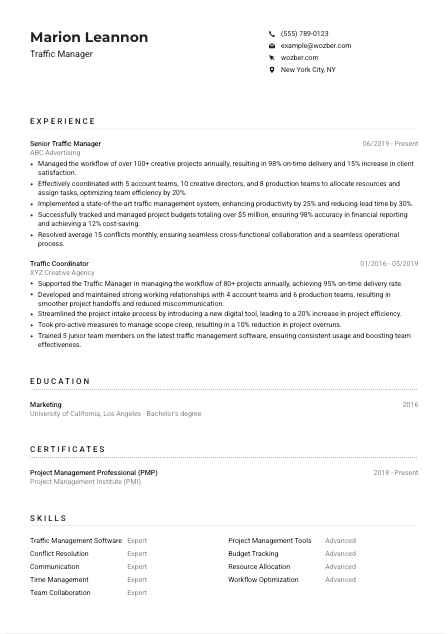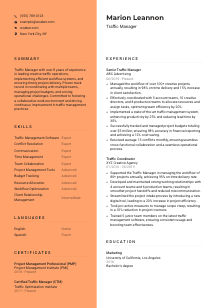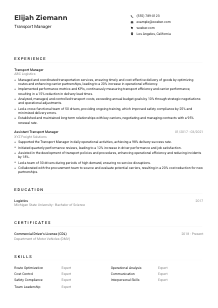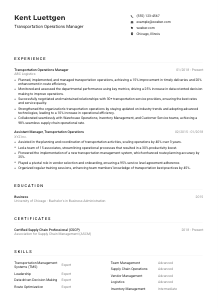Traffic Manager Resume Example
Juggling vehicles but your resume is stuck in gridlock? Navigate this Traffic Manager resume example, streamlined with Wozber free resume builder. Discover how to sync your signal coordination skills with job criteria, paving a career path that flows as smoothly as the green light!

How to write a Traffic Manager resume?
Diving into the bustling world of traffic management, your resume is the beacon that guides you through the industry's congested lanes. This isn't just any journey; it's your career path illuminated. With the Wozber free resume builder at your side, let's tailor a resume that's as dynamic as a well-coordinated traffic system, optimized to navigate through Applicant Tracking Systems (ATS) with ease. Prepare to revamp your professional story into an ATS-compliant resume that lands you in the heart of New York City!
Personal Details
In the vibrant ecosystem of traffic management, your personal details section is the 'You Are Here' marker on a map. It's where the journey begins, and clarity is key. Let's navigate this together, ensuring every detail paves the way to your next destination.
1. Shine Your Name Bright
Think of your name as the title of your personal brand's story. Ensure it beams in bold lettering, drawing the reader's gaze effortlessly. Remember, this is your marquee; let it set the stage for the narrative that unfolds.
2. Align with the Role
Position your title – Traffic Manager – directly beneath your name. This shows intent and alignment from the get-go, akin to signaling your direction in traffic, guiding the hiring manager's journey through your resume.
3. Essential Contact Touchpoints
Your phone number and email form your signal lights, guiding recruiters on how to move forward. Ensure these are clear and glitch-free. A professional email that follows the firstname.lastname@email.com format is like a neat, well-maintained road, inviting and easy to navigate.
4. Confirm Your Coordinates
Stating "New York City, NY" affirms your readiness, positioning you within the desired locale. It's like setting your GPS destination aloud, affirming to the hiring team that you're exactly where they need you to be – no detours necessary.
5. Professional Digital Footprint
Consider including a LinkedIn link or a personal portfolio website. It's like offering a live traffic feed, providing real-time insights into your professional landscape. Ensure these platforms mirror the professionalism of your resume.
Takeaway
Just like setting up a smooth route on a GPS, your personal details section must be clear, precise, and strategically aligned with your career goals. Ensure this part of your resume is a straightforward passage, leading directly to your professional narrative.





Experience
Your experience section is where you display the routes you've navigated and the traffic you've managed. It's your time to showcase how your professional journey aligns with the fluid dynamics of traffic management.
- Managed the workflow of over 100+ creative projects annually, resulting in 98% on‑time delivery and 15% increase in client satisfaction.
- Effectively coordinated with 5 account teams, 10 creative directors, and 8 production teams to allocate resources and assign tasks, optimizing team efficiency by 20%.
- Implemented a state‑of‑the‑art traffic management system, enhancing productivity by 25% and reducing lead time by 30%.
- Successfully tracked and managed project budgets totaling over $5 million, ensuring 98% accuracy in financial reporting and achieving a 12% cost‑saving.
- Resolved average 15 conflicts monthly, ensuring seamless cross‑functional collaboration and a seamless operational process.
- Supported the Traffic Manager in managing the workflow of 80+ projects annually, achieving 95% on‑time delivery rate.
- Developed and maintained strong working relationships with 4 account teams and 6 production teams, resulting in smoother project handoffs and reduced miscommunication.
- Streamlined the project intake process by introducing a new digital tool, leading to a 20% increase in project efficiency.
- Took pro‑active measures to manage scope creep, resulting in a 10% reduction in project overruns.
- Trained 5 junior team members on the latest traffic management software, ensuring consistent usage and boosting team effectiveness.
1. Dissect the Job Description
Begin by breaking down the job description, identifying keywords such as "manage workflow of creative projects" or "coordinate with account teams." These phrases are your route markers, guiding the customization of your resume.
2. Chronology is Key
List your roles in reverse-chronological order, starting with the most recent. This structure is like following a well-planned itinerary, showing your progression in the field of traffic management.
3. Map Your Achievements
Craft bullet points that mirror the job requirements, such as "Managed workflow of over 100+ creative projects annually, ensuring 98% on-time delivery." This not only showcases your abilities but also proves your aptitude for meeting critical deadlines – a must in traffic management.
4. Quantify Your Impact
Using metrics to quantify accomplishments, like "optimizing team efficiency by 20%," provides tangible evidence of your impact. It's akin to showing how you've improved traffic flow in your previous roles – with solid data to back it up.
5. Relevance Is Your Compass
Stick to experiences that directly relate to being a Traffic Manager. Imagine your resume as a map; include only the roads that lead you towards your destiny, avoiding any unnecessary detours that may confuse the itinerary.
Takeaway
Each role you include is a chapter in your career story, illustrating your evolution within the traffic management domain. Tailor and quantify your experiences to reflect the depth and breadth of your expertise, ensuring they resonate with the requirements of your desired role.
Education
In the roadmap of your career, education serves as the foundation. It's where you gained the initial insights and skills that propelled you into the world of traffic management. Let's ensure your academic background is displayed clearly, resonating with the job's prerequisites.
1. Identify the Essentials
Directly reflecting the requirement for a "Bachelor's degree in Marketing, Business, or related field," designate your degree prominently. This instantly validates your alignment with the baseline educational criteria.
2. Simplify the Layout
Maintain a clear and straightforward format when listing your education. Present the degree, field of study, institution, and graduation year in an organized manner. Imagine this as laying down the groundwork for the reader, providing them with a clear path to follow.
3. Match the Degree to the Job
Listing a "Bachelor's degree in Marketing" directly corresponds with the job's requirement, perfectly positioning you within the qualifying criteria. It's like showing your license to navigate the complex intersections of traffic management.
4. Relevant Courses or Achievements
While not always necessary, highlighting pertinent courses or academic accomplishments can add depth, especially if they directly relate to traffic management skills. Consider this as showcasing the specialized tools in your kit.
5. Additional Academic Accolades
Should you possess honors or involvement in relevant projects or organizations, briefly mention these. View them as extra lanes that add scope and versatility to your academic journey, indicating a broader understanding of traffic dynamics.
Takeaway
Your educational section should mirror the qualifications sought by the employer, establishing your groundwork in the field. Clear, concise, and pertinent information ensures this section reinforces your candidacy as a Traffic Manager.
Certificates
In the field of traffic management, continuous learning distinguishes the best from the rest. Certifications like PMP or CTM are not just accolades; they're proof of your dedication to mastering the flow of creative projects. Let's spotlight these achievements.
1. Extract the Job's Needs
Focusing on "Relevant certifications such as PMP or CTM" demonstrates your alignment with the job's preferences. It's akin to having the right credentials for navigating specific highways in the vast network of traffic management.
2. Selective Highlighting
Prioritize certifications that resonate most with the role. By showcasing your PMP or CTM, you underline your specialty in the field, much like highlighting the most efficient routes on a map.
3. Date Transparency
Mentioning the acquisition dates of your certificates, especially if they are recent, shows your current expertise level, resembling the latest traffic updates ensuring your knowledge is fresh and relevant.
4. Keep Current
The dynamic realm of traffic management constantly evolves. Regularly refreshing your certifications and seeking new ones illustrates your commitment to staying ahead of the curve, much like keeping the traffic flow smooth and efficient.
Takeaway
Each certification you list is a testament to your commitment and expertise in traffic management. Select and display them thoughtfully, ensuring they add value to your resume and resonate with the employer's needs.
Skills
Imagine your skills section as the control panel of your traffic management console. Here, you highlight the tools and techniques at your disposal, demonstrating your capability to maintain flow and efficiency. Crafting this section with care is crucial to navigating through ATS and catching the employer's eye.
1. Decode and Match
Begin by identifying key skills within the job description, such as "Strong proficiency in traffic management software" or "Exceptional communication." These are the indicators directing you on what to highlight in your own skillset.
2. Categorize Your Toolkit
Separate your skills into categories like software proficiency, communication, and project management. This helps the reader, and the ATS, quickly assess your capabilities, much like sorting traffic into lanes for smoother flow.
3. Precision and Brevity
While it might be tempting to list every skill you possess, focus on those most relevant to the Traffic Manager position. Keep this section tightly packed and to the point, ensuring only the most pertinent skills are on display.
Takeaway
The skills you list are signals to the hiring manager, showing them the routes you're capable of navigating. Make each skill count, ensuring they illuminate your suitability for the role of Traffic Manager.
Languages
In the global landscape of traffic management, the ability to communicate effectively across different cultures can be a key differentiator. Whether it's English mastery or fluency in Spanish, your linguistic talents are valuable assets. Let's convey your language skills as markers of your global readiness.
1. Review and Reflect
First, understand the role's requirements. For instance, "English language mastery required" signals the need to prioritize and clearly indicate your proficiency in English, presenting you as a fluent operator in the industry's primary language.
2. Prioritize and Present
List languages in order of relevance to the job, beginning with those explicitly requested in the job description. This ensures your linguistic skills are immediately noticeable, much like prominent road signs guiding the way.
3. Display Your Diversity
Don't hesitate to include additional languages. Each language you speak adds to your profile, enhancing your ability to navigate diverse teams and international projects, similar to understanding different traffic signs around the world.
4. Be Honest and Clear
Use standardized levels of fluency, such as native, fluent, or intermediate, to describe your proficiency accurately. Honesty ensures clear communication with potential employers, fostering a trust-based relationship from the start.
5. Role and Scope
Reflect on how your languages can benefit the specific Traffic Manager role and its challenges. Multilingual abilities might expand your capacity for managing diverse projects or negotiating across cultures.
Takeaway
Your ability to communicate in multiple languages opens doors to new opportunities and collaborations. Treat this section as your passport, displaying the range of cultures and environments you're equipped to engage with confidently.
Summary
Your summary is the high-level overview of your journey as a Traffic Manager, the billboard that captures attention and interest. Here, you compress your experience, skills, and aspirations into a clear, concise statement that resonates with the trajectory of the role you're eyeing.
1. Grasp the Role's Core
Ingest the essence of the job description, translating it into a succinct opening that speaks to your direct alignment with the role. Start with an assertive statement about your profession and experience, setting the stage for what's to follow.
2. Hit the Highlights
Distill your professional achievements and skills into bite-sized teasers. Include standout metrics or outcomes like "managing workflow of over 100+ creative projects annually" to immediately signal your capability and drive.
3. Brevity is Brilliance
Keep your summary crisp, reflecting the efficiency expected of a Traffic Manager. This isn't the place for the minutiae of your career journey; rather, it's the spot to lure the reader into wanting to know more.
4. Laser Focus
Align your summary tightly with the job's requirements, demonstrating that not only do you understand what's needed but that you embody the solution. It's your chance to claim your spot in the traffic flow, marking yourself as a clear leader.
Takeaway
Think of your summary as the central hub of your professional narrative. Here, the key routes of your career converge, showcasing your direction and destination. Let it reflect your readiness to take on the Traffic Manager role, guiding the reader through your journey with confidence and clarity.
Navigating Your Way Forward
With each section meticulously crafted, your ATS-compliant resume now stands as a testament to your readiness and relevance for the Traffic Manager role. Wozber's free resume builder, with its ATS-friendly resume templates and ATS resume scanner, ensures your resume not only meets industry standards but surpasses them. Remember, your resume is the roadmap to your career aspirations.
Fine-tune it, personalize it, and let it be the vehicle that drives you to your next great opportunity. The traffic lights are green; it's time to accelerate your career journey!

- Bachelor's degree in Marketing, Business, or related field.
- Minimum of 5 years of experience in traffic management or project coordination within an advertising or creative agency environment.
- Strong proficiency in traffic management software and project management tools.
- Exceptional communication and interpersonal skills to collaborate with cross-functional teams.
- Relevant certifications such as Project Management Professional (PMP) or Certified Traffic Manager (CTM) are preferred.
- English language mastery required.
- Must be located in or willing to relocate to New York City, NY.
- Manage the workflow of creative projects, ensuring on-time delivery while maintaining the highest quality standards.
- Coordinate with account teams, creative directors, and production teams to allocate resources and assign tasks efficiently.
- Implement and optimize agency-wide traffic management systems and processes.
- Track project budgets, expenses, and key performance indicators to report to senior management.
- Resolve conflicts and ensure timely resolution of operational issues to meet project objectives.















